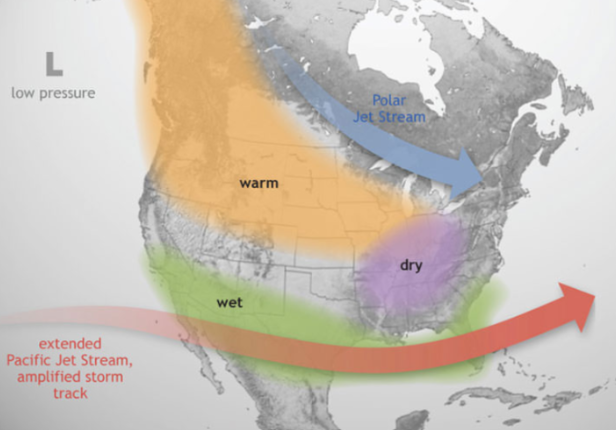El Nino: A cause of San Diego’s Abnormal Weather Pattern

You might be wondering why there is a dramatic shift in weather patterns in San Diego. The culprit is an oscillating weather pattern called ENSO which changes every 2-7 years.
El Niño Southern Oscillation (ENSO) is a naturally occurring large-scale climatic phenomenon involving fluctuating ocean temperatures in the central and eastern equatorial Pacific, coupled with changes in the overlying atmosphere.
El Niño and La Niña are the warm and cool phases of a recurring climate pattern across the tropical Pacific—the El Niño-Southern Oscillation, or “ENSO” for short. The pattern shifts back and forth irregularly every two to seven years, bringing predictable shifts in ocean surface temperature and disrupting the wind and rainfall patterns across the tropics. These changes have a cascade of global side effects. Here in San Diego, we’ve been witnessing the effects El Niño can have first hand. As heavy winds and rain batter Southern California, it’s important to know the patterns that cause these effects.
In order to understand El Niño, it’s important to understand trade winds.
The trade winds are winds that reliably blow east to west just north and south of the equator. The winds help ships travel west, and they can also steer storms such as hurricanes, too. Trade winds blow 30 Degrees North and South of the Equator and this region is known as “Horse Latitude”.
During El Niño, trade winds weaken. Warm water is pushed back east, toward the west coast of the US. When the Pacific Ocean near the Southern part of the West Coast is Warm, it results in the Jet stream from the North to dip further South bringing in Rainy Conditions to the Southwest whereas the Northwest and Canada are dryer and warmer than usual. The Pacific Jet stream extends and amplifies further into the Gulf of Mexico and Southeast and creates a wetter period than usual and causes increased rainfall and flooding. This is what we are experiencing right now. We are getting higher levels of precipitation in San Diego and the rest of Southwest and Southeast regions.
During a La Niña, the trade winds are much stronger than usual, so it pushes the Warm surface water further towards Asia and this results in upwelling. Upwelling is a process in which deep cold water which is rich in nutrients rises towards the surface.
Due to upwelling, the west coast Pacific Ocean waters are colder than usual and it pushes the Jetstream further north resulting in a drought in the southern part of the United States and heavy rain and flooding in the Pacific Northwest and Canada. During a La Niña year, winter temperatures are warmer than normal in the South and cooler than normal in the North. The onset of La Niña results in a hurricane season in the Southeast and Northeast.
The switch from El Nino to La Nina has a neutral phase in between which is called the transition phase. Like the swing of a pendulum, ENSO is one natural swing that happens every 2 to 7 years swinging back and forth between these two extreme states in a multi-year cycle. El Niño and La Niña are part of a natural cycle that can significantly impact not only global weather, climate, and ocean conditions but also food production, human health, and water supply.
Kavya Gopinath is a writer for the Talon. In her free time she enjoys bullet journaling, calligraphy, and volunteering to help folks in need across San Diego.







